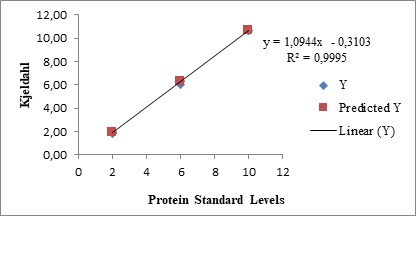The Comparison Between Kjeldahl and Ultrasonic on Milk Protein Measurement of Fresh Milk
Abstract
Kjeldahl is a method to measure protein in milk that has been recognized by many official organizations, but has many disadvantages. A saver and more efficient method is available, namely ultrasonic method that proposed as an alternative. The purpose of this research was to determine the accuracy, precision, and linearity as well as real milk protein measurement of both methods. The materials used were 30 samples of fresh cow's milk and standardized milk samples with 2%, 6%, and 10% of protein content. These samples were measured by both methods and triplicated for standardized milk. The obtained data were analyzed by descriptive and t-test for comparing both methods. The average of protein by Kjeldahl and ultrasonic while measuring fresh samples were not significantly different (2.97±0.37 vs.3.06±0,14%; p>0.05). The result of Kjeldahl and ultrasonic in the accuracy was significantly different (101.71±5.45vs.85.74±0.99%; p>0.05), but had no significantly different precision level (0,61vs.0.58%; p<0.05). The linearity test showed a good response for both methods (R² = 0.998). Finally, both methods can be used in protein measurement but Kjeldahl had more accuracy than ultrasonic.





